Angela Ackerman's Blog: Writers Helping Writers, page 41
February 27, 2023
Where to Start a Story Edit
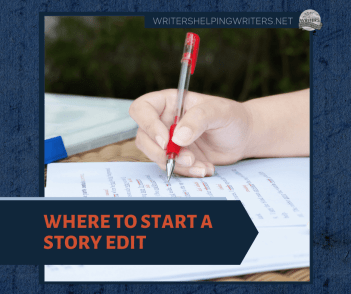
By Kristina Stanley and Lucy Cooke
Do you have a draft written but aren���t sure if there is a strong story in that draft?
In our book, Secrets to Editing Success, we go into great depth on how to perform a story edit���a structural edit���on any novel. We take the theory and show you the process to story edit.
We���re going to share some of our secrets here. And the first secret is how you know if there is a story in the draft.
The Most Important QuestionDoes the draft contain a story?
That���s a big one, and how do you answer it if you���ve just written that draft? And to go deeper, how do you answer it objectively?
First, You Perform a Story Test
What do we mean when we talk about having proof that there is a story? We are asking if you can write a synopsis.
We define a synopsis as a blurb plus the five story arc scenes plus the ending. A synopsis is a cinch when you know that���s all it boils down to.
When authors find it tough to write a synopsis, it���s normally because either they don���t have an understanding of what goes into the synopsis or there isn���t a full story yet.
A story synopsis is a tool you can use to determine if there is a story in the draft manuscript. We���re not asking you to write a polished synopsis. We���re asking you to write a skeleton synopsis.
Skeleton Synopsis = Skeleton Blurb + 5 Story Arc Scenes + Resolution
The first part of the story test is to create a skeleton blurb.
Skeleton BlurbA skeleton blurb answers three simple questions.
Who is the protagonist?What is the story goal?What is at stake?The answers to these questions are found in every story. If you cannot answer them from the draft, then we can tell you the story promised is not there yet. And the draft is not ready to be edited.
With your skeleton blurb, you found the protagonist, the story goal, and the story stakes. With your skeleton synopsis, you will find the story.
The Skeleton Synopsis is Your Next ToolA skeleton synopsis is a short description of the story.
Here is an outline for the skeleton synopsis:
The protagonist _________________ finds out the story goal __________________ (Inciting Incident). Then _______________________ happens, and the protagonist must go forward toward the story goal, (Plot Point 1). In the new ���world,��� ________________ happens, and the protagonist becomes proactive to the Story Goal (Middle Plot Point). But _______________________________ happens, and the protagonist���s hope is destroyed, they realize they must change to achieve the story goal (Plot Point 2). But the protagonist ______________________, and the world changes, they finally address the story goal (Climax).
To fill in the blanks, read the draft and find the inciting incident, plot point 1, the middle plot point, plot point 2, and the climax. Use the action in each of these scenes to fill in the blanks.
You can find out more about the story arc and how to find your story arc scenes at The Story Arc: Definitions & Examples.
Listing the Story Arc Scenes Shows You Whether There Is a Story.Does the protagonist find out the story goal,then something happens that propels the protagonist onto chasing the story goal,so that they can learn to be proactive,change themselves after all hope is lost,and use what they have learned on their journey to answer the story goal that they found at the start of their journey?What you just read is the most basic form of a story. And all great stories are structurally similar.
How to Create a Skeleton Synopsis
Step 1: Perform a Hands-Off Read-Through
A hands-off read-through means you read the story without making any changes.
Step 2: Name Every Scene
You can do this when you���re performing a hands-off read-through. A hands-off read-through means you read the story without making any changes, but you can and should make notes and name every scene.
When naming the scenes, find and label the inciting incident, plot point 1, the middle plot point, plot point 2, and the climax.
Step 3: Dig Deeper into the Story Arc Scenes
To write a skeleton synopsis at this stage, the following story elements for each story arc scene will help you set it up.
Scene NamePoint of View CharacterPoint of View Character���s GoalScene MiddleScene ClimaxScene Impact on Point of View CharacterStep 4: Create the Skeleton Synopsis
Now there are four clear steps to getting that skeleton synopsis done:
Reference the skeleton blurb.Find the five Fictionary Story Arc scenes on the story arc.List scene name, scene middle, scene climax and impact on point of view character for each of these scenes.Summarize the ending showing the story���s resolution.Step 5: Does the Draft Contain a Story?
The synopsis will help you determine if there is a story or not. You���ll find that if you can���t write the synopsis at this stage, then most likely the story is not finished. The attempt at writing a synopsis will highlight which portions of the story still need to be written.
If one of the 5 story arc scenes is missing, is in the wrong place, or doesn���t satisfy the requirements of a story scene, then there isn���t a story in the draft, yet.
It���s time to start revising the draft until the skeleton synopsis shows you there is a story. Once there is a story, you can move on to a full story edit.
All of this is covered in depth in Secrets to Editing Success: The Creative Story Editing Method.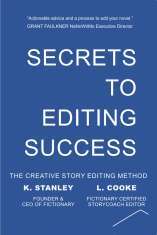
Ready to become an exceptional editor? Whether you’re working on your own manuscript or helping clients succeed, this guide shows you how to structurally edit and make every story better. Learn how to evaluate at both the story and scene level using Fictionary���s proven process and 38 Story Elements, so you know exactly what needs to be strengthened, and where!

Combining her degree in computer mathematics with her success as a bestselling, award-winning author and fiction editor, Kristina Stanley founded Fictionary and is the CEO. Fictionary helps writers and editors create better stories faster with software, an online community, editing services and training.
Her most recent publication is Secrets to Editing Success: The Creative Story Editing Method. Her novels include The Stone Mountain mystery series and Look the Other Way.��Her first novel Descent was nominated for the 2014 Arthur Ellis Unhanged Arthur for excellence in crime writing. Blaze was shortlisted for the 2014 Crime Writers��� Association Debut Dagger.

Lucy Cooke is a Fictionary Certified StoryCoach Editor and Business Development Manager at Fictionary. Secrets to Editing Success is her first book. She teaches editing through the Fictionary community, and she is an instructor for the Fictionary Certified StoryCoach program. Her passion is story, and she���s dedicated to helping others create the best story possible.
The post Where to Start a Story Edit appeared first on WRITERS HELPING WRITERS��.
February 25, 2023
Fear Thesaurus Entry: Hope
Debilitating fears are a problem for everyone, an unfortunate part of the human experience. Whether they’re a result of learned behavior as a child, are related to a mental health condition, or stem from a past wounding event, these fears influence a character’s behaviors, habits, beliefs, and personality traits. The compulsion to avoid what they fear will drive characters away from certain people, events, and situations and hold them back in life.
In your story, this primary fear (or group of fears) will constantly challenge the goal the character is pursuing, tempting them to retreat, settle, and give up on what they want most. Because this fear must be addressed for them to achieve success, balance, and fulfillment, it plays a pivotal part in both character arc and the overall story.
This thesaurus explores the various fears that might be plaguing your character. Use it to understand and utilize fears to fully develop your characters and steer them through their story arc. Please note that this isn’t a self-diagnosis tool. Fears are common in the real world, and while we may at times share similar tendencies as characters, the entry below is for fiction writing purposes only.
 Fear of Hope
Fear of HopeNotes
Hope encourages people and characters to try new things, take on challenges, and believe that things will get better. But multiple disappointments and experiences can create a fear of hope, with the character being reluctant to look forward to anything. This fear can make it difficult for them to work toward improving their situation and could make optimism a thing of the past.
What It Looks Like
Being reconciled to the status quo
Not expecting circumstances to improve
Expressing skepticism when positive things happen: It’ll never last, etc.
Living for the moment; not planning for the future
Not having dreams or goals
Believing there is nothing to live or strive for
Avoiding challenges or risks that could improve the character’s life
Being cynical when others express hopefulness
Always expecting the worst
Downplaying their own abilities (since they haven’t helped in overcoming difficulties)
Speaking of the future with skepticism
Being skeptical of other people’s promises
Scorning people who are optimistic and upbeat
Common Internal Struggles
Wanting certain circumstances to be better but truly believing there’s nothing the character can do to change them
Being unable to move beyond past disappointments, no matter how much they want to
The mind always jumping to worst-case scenarios
Feeling helpless��
Sinking into apathy and depression
The character wanting to be honest about their feelings but knowing their pessimism and negativity are bringing other people down
Burying certain emotions as they arise (anticipation, excitement, etc.)
Flaws That May Emerge
Abrasive, Apathetic, Cynical, Defensive, Foolish, Impatient, Impulsive, Indecisive, Insecure, Martyr, Melodramatic, Nervous, Paranoid, Pessimistic, Timid, Withdrawn
Hindrances and Disruptions to the Character’s Life
Missing out on career opportunities because it would have been pointless to reach for them
Staying stuck in a dead-end, toxic, or unsafe situation because the character doesn’t believe there’s anything better for them
Being unable to pursue a dream that would provide fulfillment��
Building emotional walls in relationships to keep from experiencing disappointment
Never moving past their current state of disillusionment and cynicism
Other people pigeon-holing the character as negative or gloom-and-doom
Scenarios That Might Awaken This Fear
Wanting to take a step towards a dream, but there’s a risk of failure involved (submitting a manuscript to an editor, asking someone out, etc.)
A situation with high stakes being forced on the character (being sued, being falsely accused of a crime, etc.)
Working towards a goal and getting knocked down (trying to reconcile with someone who refused to forgive the character, having another miscarriage, etc.)
Hearing about a promising job opening or promotion opportunity
A friend or loved one breaking a promise
A promising relationship ending unexpectedly
Seeing world events go from bad to worse
Other Fear Thesaurus entries can be found here.
 Need More Descriptive Help?
Need More Descriptive Help?While this thesaurus is still being developed, the rest of our descriptive collection (16 unique thesauri and growing) is accessible through the One Stop for Writers THESAURUS database.
If you like, swing by and check out the video walkthrough for this site, and then give our Free Trial a spin.
The post Fear Thesaurus Entry: Hope appeared first on WRITERS HELPING WRITERS��.
February 23, 2023
Four Reasons Your Action-Based Scene is Failing (And How to Avoid It)

We���ve all heard the writing advice that our stories must hook readers from the start, and that pacing our scenes so readers stick around is equally important. It���s all too easy to take that advice and assume we must infuse our scenes with all the makings of a blockbuster movie. Speed, chases, weapons, explosions, scary monsters, you name it. But what this advice fails to remember is that readers largely come to story for character. Specifically, they come to your story for your character, who they want to care for, worry about, and subsequently cheer for in those high-action scenes. If we don���t keep that truth at the heart of our scenes, all the trimmings of an action-packed story won���t matter. Let���s talk about four reasons readers unbuckle their seatbelts and climb out of that fast-moving vehicle of your story so we can understand how to keep them until your ride has come to a complete stop.
It���s Too Soon for High ActionJust about every set of ���rules��� for writing a riveting set of first pages leads you to believe you have to jump right into action. This is partially right and partially wrong. Inserting readers immediately into action is powerful, but inserting them into high-action too soon can fall flat. Car chases, battles, being pursued by a nefarious actor, or even meeting the protagonist participating in an intense sport don���t yield the reader���s interest in the way we expect. Why? Because the reader hasn���t had time to care about your character, much less their external circumstances. They don���t understand what���s at stake if your character can���t catch the bad guy, or if that zombie gets hold of them, or if they fail to make that winning touchdown.
The outcome of a physical-stakes-based scene scarcely matters without the underpinnings of care for the characters who are involved in it. We are banking on the notion that readers are going to be intrigued enough to know how the scene turns out. But we���ve failed to remember why readers come to story: the character���s journey.

Yes, we want to start our stories as early as possible with scene work. Nothing invites the reader into your book as a co-creator quite like loaded dialogue and interesting, revealing movement. These craft elements let the reader start making a movie in their minds. The more we can sink readers into what���s occurring in the sensory world of our characters, the better. But beware the urge to go for the big blockbuster opening scene as your first scene since the reader hasn���t had time to get their bearings and to care about the characters involved in its outcome.
The Scene Is Making Us DizzyA common pitfall of writing action scenes is that we, the writer, tend to see what every character is doing, moment by dull moment, as the scene plays out in our minds. But writing is all about handcrafting and hand-carving these scenes to reflect your protagonist���s experience (or only the most crucial players) most of all. If we���re asking the reader to notice every movement by every character, it can be dizzying. They���re trying to keep every character���s location and most recent movement, all while new character���s movements and locations are coming at them. Worse, readers start to lose track of who represents them in the scene, and what deep internal value is at stake for the primary player(s). It starts to feel like reading a bunch of stage direction instead of an edge-of-our-seats event.
Consider keeping the narrative ���camera��� as close to your protagonist as much as you possibly can. Everything happening should be filtered through them because they should have the most on the line for internal stakes in that scene. Anything you include that doesn���t stick close to the protagonist should only be included because it impacts the protagonist in a direct, powerful way (e.g., Their loved one is on the brink of disaster across the room and it���s presenting some sort of choice to your protagonist in that very moment.). If you do feel you have to include a few players��� experiences in the midst of one action scene, consider the way writers of shows like Game of Thrones direct their scenes. Oftentimes, the camera is with one player for a sustained period, and what we���re shown is almost like its own ���Act.��� Then, we rotate to another player for a sustained period and they have their own ���Act.��� As we rotate back to any given player, their story within the scene is oftentimes presented like its own 3-Act structure, but we aren���t dizzy because we���ve been in any given act for any given character for longer periods.
The Details Have Become the Haystack, And We Can���t Find the NeedleEven if you do stick close to your protagonist, resist the urge to stage direct their movements or what���s being done near them. Sometimes, we see every movement our character makes and we feel compelled to include it so the reader sees it, too. But as we overly burden the narrative with orchestrated movements, a problem emerges: Readers find it hard to pin down what matters most in the haystack of detail.
With my editing clients, I love to use an example from the film It���s a Wonderful Life. Director Frank Capra zooms in on George Bailey stashing his daughter���s flower petals into his pocket, and in drawing our attention to it, we hold onto that moment. Capra���s choice to zoom in guides us with confidence and certainty. The payoff is that George later uses those petals as a way of verifying he���s been given a second chance at life. How might you apply this in your action scenes? If you���ve given readers too much detail, it���s hard for them to judge what matters most. And when they lose their sense of what���s important to notice, they oftentimes start to skim because they can���t possibly hold onto all the details.
We Already Know the Outcome
As much as we want to think high-action scenes inherently pull their weight, the truth is that oftentimes, they don���t. We tell ourselves, what can be bigger than whether the character lives or dies? But readers know we���re not likely to kill off the characters that matter���especially if that character is your protagonist. Whenever we hinge everything on the character reaching safety or staying alive or coming out of a scene unscathed, readers experience the dreaded urge to skim. They know the outcome before they���ve read, so all that physical movement in the scene scarcely matters. It���s just stalling the story until the next scene. What really matters is why your character needs to win that scene in tangible, goal-driven terms.
Ensure that each fight/battle/high-action scene your character goes through has something at stake that���s deeper and more meaningful than their physical safety. What does losing a particular battle or not coming out on top in an action scene cost them? Why must they win beyond retaining their physical safety? What does that scene���s outcome represent that then allows the character to advance the next scene toward a larger goal?
What are some other features of high-action scenes that tend to drive you away as a reader? Are their particular techniques you use in your writing to avoid the pitfalls of too much attention on the action itself? Chime in!The post Four Reasons Your Action-Based Scene is Failing (And How to Avoid It) appeared first on WRITERS HELPING WRITERS��.
February 21, 2023
Getting Back in the Writing Flow

We all need down time in our writing lives���a planned vacation, Christmas with the family, a buffer between big projects. Sometimes we get down time whether we���ve chosen it or not (I���m looking at you, COVID). Whatever the cause, it can be good to put down our pens or shut our laptops for a while. Vacation is my time to catch up on reading, and I savor it.
But time away creates an inevitable problem: how to get back into the writing habit.
I try to coordinate vacations with the end of a novel draft and use my departure date as a deadline. For me, there���s nothing worse than leaving a novel half-written. More than three days away from a novel-in-progress and I have to read back a few chapters to remind myself where I left off and trick myself back into the rhythm of the writing. More than a week and I basically have to read from the beginning���to say nothing of reviewing all those cryptic half-written notes that no longer make any sense.
The solution is not don���t take time off. That can be a direct route to burnout. We can���t be on all the time. We need that down time to recharge our batteries. Filling the well, as Julia Cameron calls it���whether by reading or having new experiences or meeting new people. Or just doing nothing. It���s essential. Taking zero time off can result in work that feels stale; it can even kill your desire to write altogether.
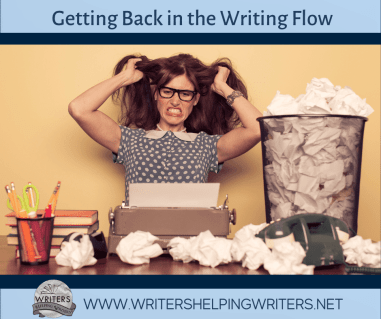
But say you have taken time off. You���ve had a great vacation and now Monday looms���the day you���ve decided it���s time to get back to your desk, back to whatever creative project you���ve been working on. You���re nervous. Afraid you���ll be rusty. Or worse: you���re afraid that whatever magic allowed you to fill the blank page is most certainly gone by now, never to return.
Of course, that���s nonsense. But if you���re anything like me, those are the thoughts running through your head. And nonsense or not, they feel real enough to cause panic.
I���ve found a few ways to smooth out the return to writing after a significant break.
Maybe they���ll work for you.
Set a date and time when you will return to your desk and SHOW UP, no matter how hard it feels. Don���t make excuses or talk yourself out of it.
Take the Pressure OffWhen I was doing my MFA, my novel-writing instructor, Gail Anderson-Dargatz gave us a mantra to follow: write crap. We had a lot of work to produce in a short period of time, and many of us were novices when it came to writing a novel. Putting pressure on yourself to be the next Margaret Atwood or write a bestseller guarantees only one thing: a blank page. When you take that pressure away and allow yourself to write anything, as long as the words show up on the page you���ve achieved your goal. As Jodi Picoult puts it, you can���t edit a blank page. And chances are, whatever you come up with won���t be crap at all.
Start By Editing Someone Else���s WorkSometimes it���s the act of sitting at your desk and moving your pen on paper that���s enough to reinspire you. If you���re editing someone else���s work, there���s nothing at stake for you. You���re not judging yourself. You���re not thinking, See? I knew I was no good, I knew the magic was gone. You���re helping someone else���and at the same time getting your mind back in the habit of thinking about craft.
Start By Editing Previous Chapters of Your Own WorkIf you did have to step away from a half-written project, ease yourself in by reading a few chapters back���or even from the beginning. It���s like giving yourself a running start. Your body and brain will get into the groove and before you know it, the ideas will be flowing again, and you���ll be adding sentences to the draft.
Try Another Art FormCreativity feeds creativity. If the idea of returning to your desk has you paralyzed, take a walk and snap some photos. If you play a musical instrument, put in some time at the piano. Draw, paint, dance. Creativity is a muscle. If you coax it, it will come back to life.
Try Using Writing PromptsPrompts can be a fun way to stretch yourself, and the internet has so many good ones now. There���s no pressure in a prompt. You���re not trying to create anything coherent. You���re just writing for, say, fifteen minutes, and the only rule is to keep your hand moving. You can do that.
Tip: One Stop for Writers has an idea generator you can use to create prompts…or help brainstorm new aspects of a current project. Today is the last day to get 25% off any One Stop for Writers subscription.
Write In a GroupThere���s a certain magic to writing in a group that���s hard to explain but I���ve found it to be undeniable. It���s as if creativity is contagious. When you surround yourself by people who are writing, you���ll write too.
The return back to writing always feels a little awkward and nerve-wracking at first. But persist and be kind to yourself. The habit will come back faster than you expect, and your work will be better for having taken the time away.
The post Getting Back in the Writing Flow appeared first on WRITERS HELPING WRITERS��.
February 18, 2023
Fear Thesaurus Entry: One’s Genetics
Debilitating fears are a problem for everyone, an unfortunate part of the human experience. Whether they’re a result of learned behavior as a child, are related to a mental health condition, or stem from a past wounding event, these fears influence a character’s behaviors, habits, beliefs, and personality traits. The compulsion to avoid what they fear will drive characters away from certain people, events, and situations and hold them back in life.
In your story, this primary fear (or group of fears) will constantly challenge the goal the character is pursuing, tempting them to retreat, settle, and give up on what they want most. Because this fear must be addressed for them to achieve success, balance, and fulfillment, it plays a pivotal part in both character arc and the overall story.
This thesaurus explores the various fears that might be plaguing your character. Use it to understand and utilize fears to fully develop your characters and steer them through their story arc. Please note that this isn’t a self-diagnosis tool. Fears are common in the real world, and while we may at times share similar tendencies as characters, the entry below is for fiction writing purposes only.
 Fear of One’s Genetics
Fear of One’s GeneticsNotes
To varying degrees, every person takes steps to stay healthy because no one wants the discomfort and inconvenience of being sick or injured. But not all maladies are created equal. Imagine a character with a genetic predisposition towards a debilitating physical or mental condition. Not knowing if it’s going to crop up for them, or when it will show itself…that uncertainty and fear can create a host of issues that impact the character’s thoughts and how they approach life and the future.
What It Looks Like
Frequently visiting the doctor
Requesting tests and bloodwork to look for earmarks of the condition
Maintaining a healthy diet
Exercising regularly
Avoiding potential triggers (alcohol, being in the sun, etc.)
Heavily researching the condition
Conducting genetic testing to see if the character is at risk
Taking vitamins and supplements
Quizzing family members about their health
Doing frequent self-checks for symptoms associated with the condition
Participating in research studies
Deciding not to have children
Hypochondriac tendencies; believing the condition is presenting when it isn’t
Difficulty developing long-term relationships (because the character doesn’t want people around when/if their health deteriorates)
Being uncomfortable around people who have the condition
Participating in fundraisers to find cures for the condition
Avoiding doctors and testing
Ignoring any symptoms of the condition
Becoming irritated or angry when the subject is brought up
Hiding signs that the condition is developing
Pretending things aren’t as bad as they are
Not making long-term plans for the future
Common Internal Struggles
The character feeling like their body or mind has betrayed them
Being plagued with visions of what the condition will do to the character
Constantly worrying that the condition is starting
Worrying about what will happen to the people in the character’s care if the condition develops
Wanting to start a family but being too afraid of passing the condition to them
Being afraid of the future and what it might bring
Wrestling with depression
Being angry at God
Flaws That May Emerge: Controlling, Fussy, Gossipy, Judgmental, Know-It-All, Morbid, Nosy, Perfectionist, Pessimistic, Pushy, Unethical, Worrywart
Hindrances and Disruptions to the Character’s Life
Overspending on genetic testing, supplements, experimental treatments, etc.
Being unable to enjoy the present because the character is so worried about the future
Not preparing adequately for the future (because the character doesn’t see the point)
Making life decisions (about marriage, having kids, the pursuit of a dream) based on the condition presenting itself though there is no guarantee that it will
Taking drastic measures to ensure the condition doesn’t develop (such as having a hysterectomy to prevent ovarian cancer, though there is no guarantee it will happen for the character)
Scenarios That Might Awaken This Fear
Watching a family member suffer with a genetically inherited condition
Experiencing symptoms of the condition
Getting a call from the doctor’s office about test results
Discovering that a family member’s devastating condition is genetic
Becoming pregnant
Birthdays that bring the character one year closer to a possible diagnosis
Seeing great strides being taken to find a cure for a different genetic condition while nothing is seemingly being done for the character’s potential condition
Other Fear Thesaurus entries can be found here.
 Need More Descriptive Help?
Need More Descriptive Help?While this thesaurus is still being developed, the rest of our descriptive collection (16 unique thesauri and growing) is accessible through the One Stop for Writers THESAURUS database.
If you like, swing by and check out the video walkthrough for this site, and then give our Free Trial a spin.
The post Fear Thesaurus Entry: One’s Genetics appeared first on WRITERS HELPING WRITERS��.
February 15, 2023
Phenomenal First Pages Contest
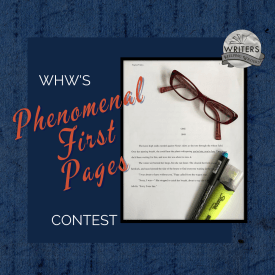 Hey, wonderful writerly people! It���s time for our monthly first-page critique contest
Hey, wonderful writerly people! It���s time for our monthly first-page critique contest 
If you���re working on a first page (in any genre except erotica) and would like some objective feedback, please leave a comment. Any comment :). As long as the email address associated with your WordPress account/comment profile is up-to-date, I���ll be able to contact you if your first page is chosen. Just please know that if I���m unable to get in touch with you through that address, you���ll have to forfeit your win.
Two caveats:
 Please be sure your first page (double-spaced in 12-point font) is ready to go so I can critique it before next month���s contest rolls around. If it needs some work and you won���t be able to get it to me right away, let me ask that you plan on entering the next contest, once any necessary tweaking has been taken care of.
Please be sure your first page (double-spaced in 12-point font) is ready to go so I can critique it before next month���s contest rolls around. If it needs some work and you won���t be able to get it to me right away, let me ask that you plan on entering the next contest, once any necessary tweaking has been taken care of.
 This contest only runs for 24 hours, start to finish, so get your comment in there!
This contest only runs for 24 hours, start to finish, so get your comment in there!
Three commenters��� names will be randomly drawn and posted tomorrow morning. If you win, you can email me your first page and I���ll offer my feedback.
We run this contest on a monthly basis, so if you���d like to be notified when the next opportunity comes around, consider subscribing to our blog (see the right-hand sidebar).
Best of luck!
PS: If you want to amp up your first page, grab our helpful First Pages checklist from One Stop for Writers. And for more instruction on these important opening elements, see this Mother Lode of First Page Resources.The post Phenomenal First Pages Contest appeared first on WRITERS HELPING WRITERS��.
February 14, 2023
Slay Your Bloated Word Count
 Practical tips to tackle a manuscript that���s too long without killing the scenes you love.
Practical tips to tackle a manuscript that���s too long without killing the scenes you love.So, you���ve written THE END on your draft, congratulations! The only problem is, your word count is way too high for your genre. I work with a lot of writers working on their first books, which I love. But I don���t love delivering hard news. Like, when a writer comes to me with a book that���s 175,000 words ��� and it���s middle grade. (If you���re new to word count norms in publishing, this is about 3x too long for a middle grade novel).
Writers come to me, wanting me to developmentally edit their book, even if they know it���s waaay too long. They hope I���ll tell them their book is so good they can publish it that way. But I can���t say that. Because here���s the problem with bloated word count:
You���re breaking reader expectations, which may result in their disappointmentYou���ll get instantly rejected by agents and publishers, thinking you haven���t done your homework (and they may not bother to tell you why)Also, please don���t compare yourself to that one breakout book that is oodles too long in your genre. Unless you already have millions of readers lined up, you haven���t earned the right to be that exception yet, because extra word count means:
Higher editing/layout costsHigher printing costsHigher costs to produce an audio-bookPublishers will have to charge an arm and a leg to make a profit on your book, so instead, they���ll pass on the opportunity to work with youEven if you publish independently, you���ll struggle to make a profit, because these costs will be yours to bear(Word count expectations depend on the genre, but can range from 50,000 for a non-fiction self help or a middle grade, to 110,000 for an adult fantasy novel. There���s a little bit of wiggle room in the ranges, but don���t be way outside. If you���re not sure what expectations are in your genre, look at similar books that have been recently published.)

If you insist on keeping every word you���ve written, you���re only making your journey to find readers harder on yourself. But I get it. You���ve spent months, probably years on your manuscript. You were so focused on producing words every time you sat down to write that you forgot to track the total word count, or maybe you didn���t even know word count was a thing.
You love your characters. You feel every scene and action you included is needed in your book. The thought of parting with any of it feels like a vice is squeezing you around the chest. But for the reasons listed above, trimming your word count will be your book���s best chance of getting discovered, read, loved, and shared, selling thousands of copies. If you want this for your book (I know you do!), you have to deal with this problem.
Sometimes, the answer is to split your manuscript into multiple books, if there���s a natural break. But usually, there���s a better, easier option. Have I got your attention? Good.
What if I told you there are places you can target in your book to get rid of word count, while making your writing even more engaging for your reader?The techniques I share here don���t require a rewrite, and will make your writing more readable and focused. You���ve got nothing to lose by giving them a try.
Slash Filler WordsWhen we speak, we use ���um��� or ���ah��� to pause when we���re thinking. In writing, writers use filler words to fill that gap while they type (or pen) their words to let their brains catch up. Weird, right?
The thing about filler words is they���re not incorrect. Your sentences will read fine with them, so spell check won���t catch them. But about 80% of the time, these words distract the reader, and the sentence can be restructured without them. Note: Sometimes these words serve a purpose, so please don���t delete them all, you���ll have to do a FIND (ctrl F on most keyboards will get you to the find function) and look at them one at a time. I���ve had dozens of clients weed out 3,000 words or more from a manuscript just by using this trick (that���s 12 pages of filler!), so it���s totally worth your time.
Some of the most common words writers use as filler are
ThatJustLikeBut there are dozens more. You might be surprised which words you���re sticking into sentences as you go.
I���ve personally had a different problem word with each book I���ve written that I didn���t notice until the revision stage. Brains are amazing, right? Run your manuscript against the full list of filler words/phrases I���ve compiled. You can get a PDF list here.
Kill Filter Words/PhrasesFilter words, like Filler words are unnecessary in your writing. But these have the added consequence of making your readers care less about your characters and their journeys, because they are used to distance your Point of View (POV) character from the actions your characters are taking. When you use them, it���s like you���ve inserted a filter or narrator between your reader and what���s happening on the page. This doesn���t make them feel like they���re in your book, experiencing what your character is experiencing.
If you read a lot of classic books, you���ll see their pages are riddled with filter phrases. So, if you���re going for more of a literary or old-timey feel, a few filter phrases might be fine. But in recent years, deep point of view is becoming more popular, and removing these phrases will drag your readers in more. Not to mention, since you���re eliminating several words with each instance, removing them can reduce word count fast, and that���s what we���re targeting in this list.
Look for these verbs that indicate you might be using filter phrases and see if you can rework the sentence without them. Aim to reduce these by 90% if you can. Some examples to search for and remove include:
to see
to hear
to think
to touch
to wonder
to realize
to watch
to look
to seem
to feel
feel like
can
to decide
to sound
to notice
to be able to
to note
notice
seemed
to experience
spotted
saw
realized
felt
thought
wondered
believed
knew
decided
observed
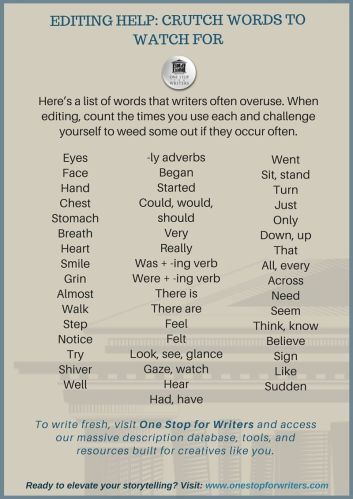 Download Crutch Word List
Download Crutch Word List
If you���re writing for adults, dialogue tags (example: she said) aren���t strictly necessary. Look for places in your draft where you have a dialogue tag and then an action beat, like this:
Instead of (10 words):
���Your word count is shrinking,��� Suzy said (dialogue tag), clapping her hands (action beat).
Try (9 words):
Remove the dialogue tag, and leave only the action beat.
���Your word count is shrinking.��� Suzy clapped her hands.
Note: If you���re writing middle grade or for a lower reading level, you���ll want to leave the dialogue tags in, because newer readers need them for comprehension. But if you���re writing for adults? Go to town. Just be sure to leave the action beats there so that readers can tell who���s talking.
Remove Character Names in DialogueThis one���s easy.
If you phoned me right now, you could say, ���Suzy, this advice is awesome!���
But it���s less words to say, ���This advice is awesome!��� and it means the same thing, since I know you���re talking to me. Plus, in real life, we don���t go around using people���s names all the time. It���s just awkward.
Combine Repeated Scenes, Recaps, or CharactersIf your word count is still too high, don���t despair. The next place to look is for places in your book that feel similar.
Do your characters visit a location several times? See if you can combine the events into less visits to that location. You���ll keep all the ���stuff��� that happens, but combining scenes will give you lots of opportunity to tighten up word count.Do you have a scene where a character is telling their brother about something that the reader already witnessed in an earlier scene? Don���t make us hear it all again *yawn*. Reduce it to a quick recap:Geronimo filled Luther in on the fist fight.Have a few characters that ended up with similar goals and voices? Combine them into one person. This allows you to keep dialogue, keep events, even backstory, but will definitely save you word count, because you have less characters to introduce and include.

Even if you love your draft the way it is, try to keep an open mind. Fitting within a genre���s word count expectations will make your book more accessible to readers, and more saleable. And ultimately, these changes will make your writing as strong as it can be, so it���s a win-win situation.
Looking for more practical writing tips?I share some of my best tips writing tips in my all-new free Masterclass. Watch it here.
Before you go…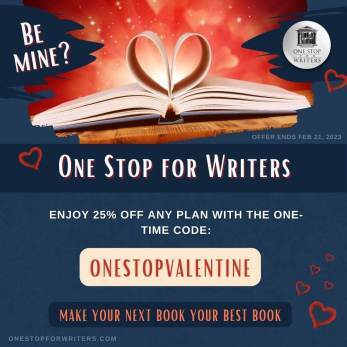
Angela here to say Happy Valentine’s Day! Becca and I want you to have not just a stellar day, but a stellar career, so we’ve wrapped up a sweet discount on our One Stop for Writers plans.
So if you like, use this one-time code:
ONESTOPVALENTINE
To receive a one-time 25% discount on any of our plans.
To redeem:
Sign in or Sign up Go to ACCOUNT >> My Subscription & choose a planActivate the code ONESTOPVALENTINE using the box providedAdd your payment details, tick the terms box, and hit subscribe.We love helping you through our books and blog, but One Stop for Writers is where we have the most tools, resources, thesauruses, and step-by-step help, so we hope you check it out if you need additional support.
Enjoy the day and be good to yourself!
The post Slay Your Bloated Word Count appeared first on WRITERS HELPING WRITERS��.
February 11, 2023
Fear Thesaurus Entry: Sex
Debilitating fears are a problem for everyone, an unfortunate part of the human experience. Whether they’re a result of learned behavior as a child, are related to a mental health condition, or stem from a past wounding event, these fears influence a character’s behaviors, habits, beliefs, and personality traits. The compulsion to avoid what they fear will drive characters away from certain people, events, and situations and hold them back in life.
In your story, this primary fear (or group of fears) will constantly challenge the goal the character is pursuing, tempting them to retreat, settle, and give up on what they want most. Because this fear must be addressed for them to achieve success, balance, and fulfillment, it plays a pivotal part in both character arc and the overall story.
This thesaurus explores the various fears that might be plaguing your character. Use it to understand and utilize fears to fully develop your characters and steer them through their story arc. Please note that this isn’t a self-diagnosis tool. Fears are common in the real world, and while we may at times share similar tendencies as characters, the entry below is for fiction writing purposes only.
 Fear of Sex
Fear of SexNotes
Sex is one of the most intimate means of human connection, so some anxiety surrounding it is normal. But deeper fears can easily develop in this area because of its intimate nature and the vulnerability involved, especially if a person has suffered past trauma or has a physical condition that makes sex painful. When this happens, the character may seek to avoid something that should be natural, pleasurable, and a means to grow in intimacy with others.
What It Looks Like
Having little to no interest in sex
Not engaging in conversations around sex
Hesitancy towards romantic relationships
Avoiding romantic or erotic movies
Turning down dates
Taking a vow of celibacy
The character making themselves undesirable (dressing down, covering exposed skin, slouching, etc.)
Responding coldly or awkwardly to flirting
The character showing signs of discomfort when they’re with someone who expresses romantic interest
Intentionally sabotaging relationships
Making excuses for not having sex
Shying away from being touched
Having to self-medicate to engage in sexual activity
Nervousness about showing skin or taking off clothes (going swimming, wearing tank tops, etc.)
Being triggered by pornography
Subconsciously sabotaging a partner’s attempts at emotional intimacy (because this will lead to requests for sex)
The character overcompensating by bragging about sexual exploits that have never happened
Seeing a sex therapist
Common Internal Struggles
Wanting to find a life partner but being afraid of intimacy
Wanting sex but being unable to complete the act
Difficulty being vulnerable with others
The character feeling insecure about their body
The character not understanding why sex is so natural for others but it’s a source of pain, shame, anxiety, or fear for them
Grappling with memories of sexual trauma
Feeling shame or self-loathing at their inability to perform
Being riddled with guilt and feelings of selfishness for being unable to meet a partner’s sexual needs
The character experiencing confusion about their sexual identity
Developing unhealthy ideas about sex (that it’s dirty, transactional, a means of control, etc.)
Flaws That May Emerge
Addictive, Antisocial, Cynical, Defensive, Dishonest, Inattentive, Inflexible, Inhibited, Insecure, Jealous, Macho, Nervous, Oversensitive, Suspicious, Uncommunicative, Withdrawn
Hindrances and Disruptions to the Character’s Life
Being unable to find someone to go through life with
Difficulty opening up to others
Developing a sexual dysfunction
Feeling uncomfortable and awkward when sex is discussed, referenced, included in a movie, etc.
Being sexually unfulfilled
Sex becoming an act that must be endured rather than something pleasurable to be shared
Scenarios That Might Awaken This Fear
Being stalked or harassed
Friends gossiping about their sexual experiences
Meeting a potential partner the character would like to pursue a deep relationship with
An unexpected sex scene in a movie or book
Someone flirting with the character
Being touched without consent
Certain types of medical exams
A partner insisting on couple’s therapy, where the character will have to discuss sex and explore their feelings and memories about it
Other Fear Thesaurus entries can be found here.
 Need More Descriptive Help?
Need More Descriptive Help?While this thesaurus is still being developed, the rest of our descriptive collection (16 unique thesauri and growing) is accessible through the One Stop for Writers THESAURUS database.
If you like, swing by and check out the video walkthrough for this site, and then give our Free Trial a spin.
The post Fear Thesaurus Entry: Sex appeared first on WRITERS HELPING WRITERS��.
February 9, 2023
Creating a Moral Villain

As readers, what inspires empathy for the hero and makes us root for him? Their flaws? Admirable qualities? Hopeless circumstances? Yes, to all of the above. But none of these elements would be effective without a worthy villain to complicate matters.
This is the real purpose of the antagonist: to make things unlivable for the hero and ramp up reader empathy. I mean, would we care so much about Snow White without the Queen? Maximus without Commodus? The Smurfs without Gargamel? Villains are important because they���re the ones who determine how bad things will get for the hero. It is fear of this antagonist that inspires empathy in readers, putting them firmly in the hero���s cheering section and ensuring they will keep turning pages. So it���s crucial you create a villain who is just as unique, interesting, and believable as the main character.
One way to do this is by including the Evil-By-Nature Villain. These are the antagonists who don���t have a backstory. They do what they do because it���s in their blood or their programming. The shark in Jaws. Ellen Ripley���s alien. The Terminator. Such a ruthless and seemingly unstoppable villain puts the hero in extreme danger because the enemy can���t be reasoned with or talked out of its determination to destroy. Villains like these, with little or no backstory, can be terrifying in their own right.
But there absolutely are worse bad guys. While a twenty-five foot shark might keep me out of the water, it won���t keep me up at night. The villains who accomplish this are the ones who feel real. They have morals���albeit skewed���and live by them. Though a nightmare now, they weren���t born that way; life, past events, and the evil of others have made them the villains they are today. They���re terrifying because they were once normal���just like me.
It is this kind of antagonist we should strive to create: moral villain who strictly adhere to their twisted moral codes. Here are some tips on how to bring them to life:
Know the Villain���s BackstoryWe spend a lot of time digging into the hero���s history, but what if we dedicated even half as much energy researching our villain? Who were their caregivers? What were they like in the past? What happened that changed them? Who was kind to them? Who was cruel? Every villain has a backstory that should explain why they are the way they are today. Dredge it up and create a profile. Then dole out the important bits to readers so they can get a glimpse of who the villain used to be and how they became a monster.
Tip: The free Reverse Backstory Tool can help you achieve this!
Know the Villain���s Moral CodeWe don���t tend to think of villains as moral individuals, but they usually are. They just live according to a different set of values than the rest of society.
Morals have to do with our beliefs about right and wrong. To make your villain truly ominous, give them a reason for doing what they do. Make her believe there is value in their choices. For example, through her abusive past and twisted religious beliefs, Margaret White (Carrie) finds it acceptable to verbally and physically abuse her daughter. Anton Chigurh, the heartless villain from No Country for Old Men, adheres to a moral code that isn���t explained; the audience doesn���t know why he chooses to let some people live and others die, but whatever his reasons, he believes firmly in them and acts accordingly.
It���s one thing for a character to engage in reprehensible behavior. An element of creepiness is added when they defend that behavior as being upright and acceptable. To pull this off, you need to know your villain���s moral code.
Know the Villain���s BoundariesMorality isn���t just about what���s right; it also includes a belief that certain ideas are inherently wrong. Are there things your villain won���t do, lines they won���t cross? Why? Show their human side and you���ll make them more interesting. You might even manage to create some reader empathy, which is always a good thing.
Give the Villain Someone to Care About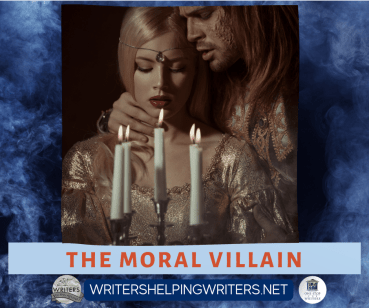
Love is a moral concept���the idea that a person cares more for someone else than they do for themselves. Show that your villain is capable of caring, and you���ll add a layer of depth to their character.
On the TV show The Blacklist, serial criminal Raymond Reddington seems to have no boundaries. As long as it suits his purposes, he���ll sell out anybody���except FBI Agent Elizabeth Keen. This obsessive attachment not only gives him a human side, but it���s intriguing to the audience, who wants to know why he cares for her when he���s so ruthless in every other area of life.
No one���s going to cheer for a hero whose adversary is superficial or unrealistic. Turn your villain into a truly horrific creature by giving them a moral code to live by. Unearth their backstory and show readers that, at one point, they were human. It���s a good reminder that we���re all just one bad experience away from becoming monsters ourselves.
The post Creating a Moral Villain appeared first on WRITERS HELPING WRITERS��.
The Moral Villain

As readers, what inspires empathy for the hero and makes us root for him? Their flaws? Admirable qualities? Hopeless circumstances? Yes, to all of the above. But none of these elements would be effective without a worthy villain to complicate matters.
This is the real purpose of the antagonist: to make things unlivable for the hero and ramp up reader empathy. I mean, would we care so much about Snow White without the Queen? Maximus without Commodus? The Smurfs without Gargamel? Villains are important because they���re the ones who determine how bad things will get for the hero. It is fear of this antagonist that inspires empathy in readers, putting them firmly in the hero���s cheering section and ensuring they will keep turning pages. So it���s crucial you create a villain who is just as unique, interesting, and believable as the main character.
One way to do this is by including the Evil-By-Nature Villain. These are the antagonists who don���t have a backstory. They do what they do because it���s in their blood or their programming. The shark in Jaws. Ellen Ripley���s alien. The Terminator. Such a ruthless and seemingly unstoppable villain puts the hero in extreme danger because the enemy can���t be reasoned with or talked out of its determination to destroy. Villains like these, with little or no backstory, can be terrifying in their own right.
But there absolutely are worse bad guys. While a twenty-five foot shark might keep me out of the water, it won���t keep me up at night. The villains who accomplish this are the ones who feel��real. They have morals���albeit skewed���and live by them. Though a nightmare now, they weren���t born that way; life, past events, and the evil of others have made them the villains they are today. They���re terrifying because they were once normal���just like me.
It is this kind of antagonist we should strive to create: moral villain who strictly adhere to their twisted moral codes. Here are some tips on how to bring them to life:
Know the Villain���s BackstoryWe spend a lot of time digging into the hero���s history, but what if we dedicated even half as much energy researching our villain? Who were their caregivers? What were they like in the past? What happened that changed them? Who was kind to them? Who was cruel? Every villain has a backstory that should explain why they are the way they are today. Dredge it up and create a profile. Then dole out the important bits to readers so they can get a glimpse of who the villain used to be and how they became a monster.
Tip: The free Reverse Backstory Tool can help you achieve this!
Know the Villain���s Moral CodeWe don���t tend to think of villains as moral individuals, but they usually are. They just live according to a different set of values than the rest of society.
Morals have to do with our beliefs about right and wrong. To make your villain truly ominous, give them a reason for doing what they do. Make her believe there is value in their choices. For example, through her abusive past and twisted religious beliefs, Margaret White (Carrie) finds it acceptable to verbally and physically abuse her daughter. Anton Chigurh, the heartless villain from��No Country for Old Men, adheres to a moral code that isn���t explained; the audience doesn���t know why he chooses to let some people live and others die, but whatever his reasons, he believes firmly in them and acts accordingly.
It���s one thing for a character to engage in reprehensible behavior. An element of creepiness is added when they defend that behavior as being upright and acceptable. To pull this off, you need to know your villain���s moral code.
Know the Villain���s BoundariesMorality isn���t just about what���s right; it also includes a belief that certain ideas are inherently wrong. Are there things your villain won���t do, lines they won���t cross? Why? Show their human side and you���ll make them more interesting. You might even manage to create some reader empathy, which is always a good thing.
Give the Villain Someone to Care About
Love is a moral concept���the idea that a person cares more for someone else than they do for themselves. Show that your villain is capable of caring, and you���ll add a layer of depth to their character.��
On the TV show The Blacklist, serial criminal Raymond Reddington seems to have no boundaries. As long as it suits his purposes, he���ll sell out anybody���except FBI Agent Elizabeth Keen. This obsessive attachment not only gives him a human side, but it���s intriguing to the audience, who wants to know why he cares for her when he���s so ruthless in every other area of life.
No one���s going to cheer for a hero whose adversary is superficial or unrealistic. Turn your villain into a truly horrific creature by giving them a moral code to live by. Unearth their backstory and show readers that, at one point, they were human. It���s a good reminder that we���re all just one bad experience away from becoming monsters ourselves.
The post The Moral Villain appeared first on WRITERS HELPING WRITERS��.
Writers Helping Writers
- Angela Ackerman's profile
- 1022 followers



